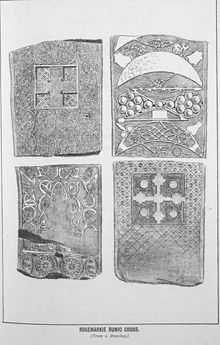Rosemarkie Stone

The Rosemarkie Stone or Rosemarkie Cross, a Class II Pictish stone, is one of the major surviving examples of Pictish art in stone.
Carved from fine-grained sandstone, the Rosemarkie stone was found in the ancient churchyard of the village of Rosemarkie, probable site of a major Pictish monastery, on the Black Isle of Easter Ross and is now on display in Rosemarkie's Groam House Museum (open in summer; entrance charge).
On the front side is an elaborately decorated cross, while on the reverse side are various common Pictish symbols, including three crescents and v-rods and a double-disc and Z-rod, as well as a smaller cross at the bottom. It is the only Pictish stone to bear three versions of the same symbol. The sides are also decorated with a number of interlace patterns.
See also
References
- Fraser, Iain, Ritchie, J.N.G., et al., Pictish Symbol Stones: An Illustrated Gazetteer, (Royal Commission on the Ancient and Historical Monuments of Scotland, 1999)
- Jones, Duncan, A Wee Guide to The Picts, (Musselburgh, 2003)
- MacNamara, Ellen, The Pictish Stones of Easter Ross, (Tain, 2003)
External links
| |||||||||||||||||||||||
Coordinates: 57°35′29″N 4°6′48″W / 57.59139°N 4.11333°W